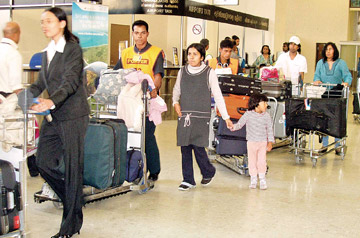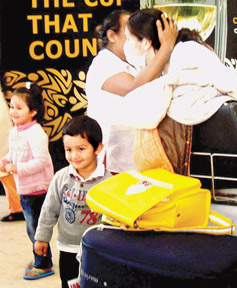Sri Lankans return after harrowing ordeal in Japan
Manjula Fernando

First batch of Sri Lankan evacuees on arrival at the BIA.
Airport Pix: Kumarasiri Prasad |
They lived in a town north of Tokyo, towards the midlands, many miles
away from the disaster-hit Sendai and the nuclear danger zone at the
Fukushima Daiichi nuclear power plant.
“We were in Oyama, about 150 - 160 kilometres from the nuclear plant,
but did not want to take a chance,” a woman who did not want to be
identified told the Sunday Observer. She arrived at the Bandaranaike
International Airport on Friday, on board the first SriLankan Airlines
emergency flight from the disaster struck Japan.
She said the situation grew uncertain by the day and they decided to
leave, although it meant leaving behind almost all their belongings.
They feared a possibility of a bigger explosion at the nuclear plant.
Sharing her feeling with us over the phone she said, “the Japanese
government made announcements from time to time warning the people to
stay indoors all the time. If we were to leave the house for some
emergency, we had to cover the body entirely and wear face masks. The
feeling of uncertainty was unbearable. The disaster struck on Friday and
we felt the earthquake fairly strongly.”
But there was no tsunami impact as Oyama is in the middle of Japan.
From that day onwards everyone was glued to television for news of
some improvement. But then the news of explosions at the nuclear plant
arrived. Later food and fuel became a scarcity. We had to languish in
queues for nearly four hours to pump 1,000 yen worth of petrol.
 |
|
Another family with tiny
tots |
We were told they had to send the supplies for affected people in
Sendai and this was the reason petrol had to be used sparingly. No one
protested against this. Everyone was grief stricken and sympathetic.
We had been living in Oyama for five years and I am married to a
Japanese. My son was also employed there. In the rush to catch the
special flight we grabbed just a few belongings we could put in a
suitcase.
The rest had to be left behind. The house was on lease but there were
so many valuables. It was a tough decision.
|

A hug from a near and dear |
My husband came along too. He was issued an on-arrival visa which
will last for one month. We don’t know what to do after one month. Our
Japanese friends who have had experience and are better informed of
nuclear disasters told us that the impact of the blasts at nuclear plant
would be felt for over may be two years.
After the explosions at the plant the fumes drifted into the sky,
then there was rain and snowfall. This rain water may be contaminated. I
am not an expert but this is what I heard from our Japanese friends.
But we all have enormous faith in the Japanese Government that they
will look after our friends and relatives in Japan. They will avert any
major crisis.
We are not sure when we will be going back to Japan although our
whole life is over there.
She said there were more Lankans who are waiting to come to Sri Lanka
but are unable to pay the airfare. These are mostly workers without
visas.
They send all their money to Sri Lanka and live on a pittance until
the next month’s salary. These people are in a real crisis.
There are a lot of Sri Lankans working there without visas.
Processing their return journey is not easy. They have been asked to
produce a lot of documents from Sri Lanka. Given the fact that the
postal services are not so regular after the disaster, it will not be so
easy for them to get out of there. I think the Government should get
involved and help them to come back. After all every cent of their
earnings has been sent here to their loved ones.
When I heard that a specially chartered flight from Sri Lanka is
arriving here on Thursday to evacuate Sri Lankans I got in touch with
the Airline’s Ticketing Agent on Wednesday.
It seems “the Travel agent doing the ticketing on behalf of SriLankan
Airlines is over charging. Here, people were frantically trying to get
back to our country safely. It was a real crisis.
These people were trying to fish in troubled waters. The authorities
must investigate this and take action.”
From Wednesday to Thursday she had been trying to confirm her flight
but until they reached the airport she could not get any confirmation
and neither was she convinced that they could board the flight.
Nonetheless they decided to brave the journey, a risk that would not
have been so serious if there had not been an acute fuel crisis. A
friend offered them a lift for half the journey. They could travel in
his vehicle as far as his fuel quota permitted.
“He had to save fuel for his return journey. Our town was about 80
kilometres away from Tokyo’s Narita airport. We came in his car half way
and got into a taxi from there.” The flight was waiting for them. It was
a sigh of great relief.
“We must thank our President for arranging this special plane to
bring us back home,” a mother of two young children, Thamashi (30) said.
She is one of the evacuees who returned from Japan with her
five-year-old son and five month old daughter. Thamashi with her family
was residing in Yodoku, a town not very far from Tokyo for the past ten
years.
“I had to leave my husband and come. He was not given leave from his
workplace.” Tamashi was compelled to come to ensure the safety of her
two kids.
According to her the Japanese authorities have warned the radiation
could be particularly dangerous for young children. She says her husband
could get official leave if the Sri Lankan authorities issue them a
letter acknowledging their plea.
If the situation turns worse, my husband and his brother will also
return to Sri Lanka. Our future is so uncertain as we had to leave all
our belongings and the well paid jobs, she lamented. She said most of
those who arrived in the first flight were pregnant mothers and mothers
of young children.
She had paid Rs. 113,000 for her air ticket and Rs. 89,000 for her
five year old son and Rs. 35,000 for a one way ticket for her infant
daughter. Tamashi also confirmed that there seem to be a racket
involving tickets. She had booked her ticket from the same agent as the
other lady on the instructions of the SriLankan Airlines office at
Narita airport.
“This has to be looked into to make sure that the same fate will not
befall other passengers,” she stressed while adding that if the Sri
Lankan mission in Tokyo could take over the ticketing and facilitating
the emergency flights it would be an immense relief to stranded Sri
Lankans.
The Airbus scheduled to depart at 4.20 p.m. from Narita airport on
that day took off behind schedule at 8.00 that night. After a six and a
half hour journey it touched down in Bangkok. There they spent over two
hours.
Then after a three and a half hour journey the flight arrived in
Colombo with 280 evacuees from Japan around 6 a.m. on Friday the 18th
morning. |

